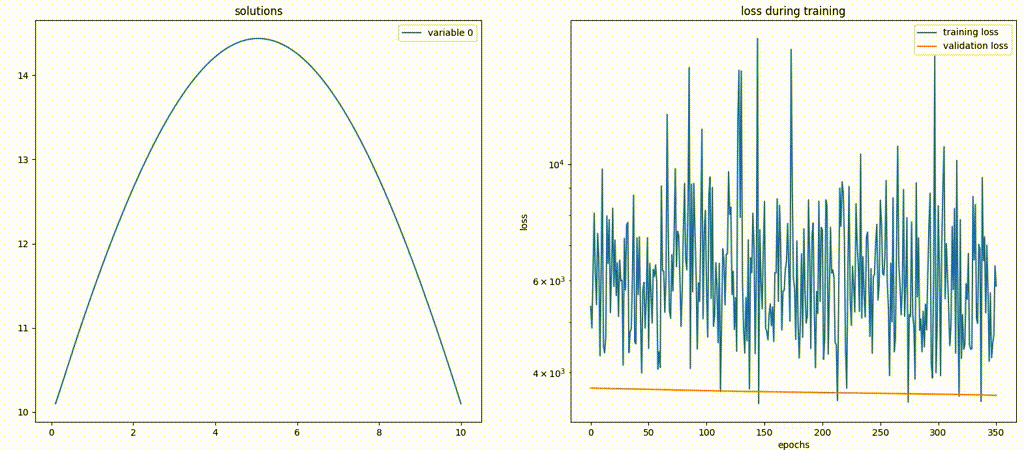Rethink the diff function
At the core of the neurodiffeq library is the diff(x, t) function, which computes the partial derivative ∂x/∂t evaluated at t. Usually, both tensor t and x have shapes of (n_samples, 1). When either x.shape or t.shape is malformed, however, there are cases where things could go wrong due to broadcasting. Such cases are so subtle that they have gone unnoticed for a long time.
All our generators (as defined in neurodiffeq.generator) currently return tensors with shapes (n_samples,) instead of (n_samples, 1). Efforts should be put into unifying the tensor shapes everywhere.
Here are two simple cases for review.
Case 1: Shapes don't matter
In this case, we try different combinations of x.shape and t.shape and check the shape of the output ∂x/∂t, namely:
[n, 1] and [n] --> [n][n] and [n]--> [n][n, 1] and [n, 1]--> [n,1][n] and [n, 1]--> [n,1]
To see this, run the following code. Note that d1, d2, d3, and d4, while having different shapes, hold the same values. This is the reason why we incorrectly believed in the soundness of the diff() function.
n = 10
t = torch.rand(n, requires_grad=True)
x = torch.sin(t)
d1 = diff(x.reshape(-1, 1), t)
d2 = diff(x.reshape(-1), t)
t = t.reshape(-1, 1)
x = torch.sin(t)
d3 = diff(x.reshape(-1, 1), t)
d4 = diff(x.reshape(-1), t)
Case 2: Shapes matter
In this second case, we examine two new operators – div and curl in spherical coordinates – and show that only when x.shape and t.shape are both (n, 1) will the vector identity div(curl(...)) == 0 hold.
Here is the definition of curl and divergence in spherical coordinates
# these two operators have been recently implemented in neurodiffeq.operators
def spherical_curl(u_r, u_theta, u_phi, r, theta, phi):
d_r = lambda u: diff(u, r)
d_theta = lambda u: diff(u, theta)
d_phi = lambda u: diff(u, phi)
curl_r = (d_theta(u_phi * sin(theta)) - d_phi(u_theta)) / (r * sin(theta))
curl_theta = (d_phi(u_r) / sin(theta) - d_r(u_phi * r)) / r
curl_phi = (d_r(u_theta * r) - d_theta(u_r)) / r
return curl_r, curl_theta, curl_phi
def spherical_div(u_r, u_theta, u_phi, r, theta, phi):
div_r = diff(u_r * r ** 2, r) / r ** 2
div_theta = diff(u_theta * sin(theta), theta) / (r * sin(theta))
div_phi = diff(u_phi, phi) / (r * sin(theta))
return div_r + div_theta + div_phiHere we define a vector field q by specifying the rule to compute q given coordinates (r, theta, phi)
def compute_q(r, theta, phi):
r_theta_phi = torch.stack([r.flatten(), theta.flatten(), phi.flatten()], dim=1)
W = torch.tensor([
[.01, .04, .07],
[.02, .05, .08],
[.03, .06, .09],
])
q = torch.matmul(r_theta_phi, W)
q = torch.tanh(q)
return q[:, 0], q[:, 1], q[:, 2]We then test the vector identity div(curl(q)) == 0 for q
n = 10
# create r, theta, and phi with shape (n, 1)
r = torch.rand(n, 1, requires_grad=True) + 0.1
theta = torch.rand(n, 1, requires_grad=True) * np.pi
phi = torch.rand(n, 1, requires_grad=True) * np.pi * 2
q_r, q_theta, q_phi = compute_q(r, theta, phi)
# bind the operators to the r, theta, phi created above
div = lambda u_r, u_theta, u_phi: spherical_div(u_r, u_theta, u_phi, r, theta, phi)
curl = lambda u_r, u_theta, u_phi: spherical_curl(u_r, u_theta, u_phi, r, theta, phi)
div_curl_q1 = div(*curl(q_r.reshape(-1, 1), q_theta.reshape(-1, 1), q_phi.reshape(-1, 1)))
div_curl_q2 = div(*curl(q_r.reshape(-1), q_theta.reshape(-1), q_phi.reshape(-1)))
# create r, theta, and phi with shape (n,)
r = r.reshape(-1)
theta = r.reshape(-1)
phi = r.reshape(-1)
q_r, q_theta, q_phi = compute_q(r, theta, phi)
# bind the operators to the r, theta, phi created above
div = lambda u_r, u_theta, u_phi: spherical_div(u_r, u_theta, u_phi, r, theta, phi)
curl = lambda u_r, u_theta, u_phi: spherical_curl(u_r, u_theta, u_phi, r, theta, phi)
div_curl_q3 = div(*curl(q_r.reshape(-1, 1), q_theta.reshape(-1, 1), q_phi.reshape(-1, 1)))
div_curl_q4 = div(*curl(q_r.reshape(-1), q_theta.reshape(-1), q_phi.reshape(-1)))
print(div_curl_q1, div_curl_q2, div_curl_q3, div_curl_q4, sep="\n")
Printing all four div_curl_qs will show that, only div_curl_q1 is (approximately) equal to 0, which means both the dependent and independent variables must have shape (n, 1) for the differentiation to go correctly.





